Over two million Irish people emigrated between 1845 and 1855. But did they all sail on so-called "coffin ships"? Cian T. McMahon uses the surviving statistics to find out.
When I was growing up in Dublin in the 1970s and '80s, the phrase ‘coffin ships' was synonymous with emigration during the Great Famine. Frankly, the images it conjured up – of boatloads of dead bodies being tossed about on the high seas – were terrifying. But as I grew older and spent more time reading and writing about history, I became ever more suspicious of this two-dimensional image of emigrant vessels as ‘coffin ships’.
I came to realise that the phrase, originally designed to honour the memory of the catastrophe’s victims, actually stripped them of their individuality and humanity. This group memory, which reduced Famine-era emigrants to undifferentiated masses of silent bodies, lying prone in the bottom of ‘coffin ships’, had erased any sense of them as people – mums, brothers, cousins, and friends – from places like Kanturk, Gorey, and Ballymoney.
The British government got a lot of things wrong during the Great Famine. But, as paragons of imperial bureaucracy, they were good at collecting statistics. Using the tables and charts they left behind allows us to figure out a more accurate picture of emigrant mortality during the Famine and thus – ironically – take a crucial first step towards recapturing the humanity of its victims.
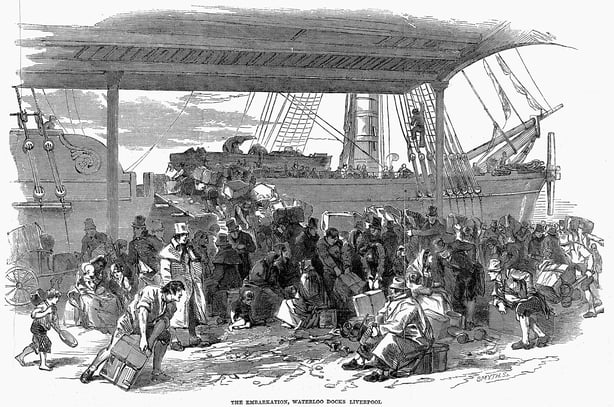
Emigrant mortality in context
Irish emigrant mortality in the late 1840s and early 1850s only makes sense when placed in the context of maritime mortality more broadly at the time. In the early 1700s, slave ships on the Middle Passage (one leg of the triangular trade route from Europe to America), had death rates of over 15 per cent but, by the early 1800s, that terrible statistic had been reduced to around 10 per cent. Europeans enjoyed much safer voyages. Whether sailing to Australia or North America, the average European emigrant ship could expect a mortality rate of between 1 and 2.5 per cent. So, if a ship left Le Havre for New Orleans in the late 1840s with 200 passengers aboard, no one would be surprised if three or four of them (probably newborns or the elderly) died along the way.
The surviving statistics on Irish maritime mortality during the Great Famine are imperfect. Given that 75 per cent of Ireland’s Famine emigrants passed through Liverpool, one of the world’s leading emigration depots at the time, it is impossible to say with certainty that the people on any given ship were all actually Irish. There were often Scottish, English, Germans, and others mixed in.
Nevertheless, it is clear that the statistic of 20 per cent mortality, which has long been accepted as the death rate for Famine-era Irish ships, is simply inaccurate. In fact, between 1845 (when the Famine broke out) and 1855 (when the annual rate of emigration returned to pre-Famine levels of less than 80,000), the total death rate for Irish people on emigrant ships and in quarantines like Grosse Île, was around 3 per cent. This means that approximately 97 per cent of the 2.2 million who emigrated during the Great Famine, made it safely to their destination.
Beyond Black ‘47
This does not mean, however, that if an Irish person got an emigrant ship between 1845 and 1855, they had a 3 per cent chance of dying. In fact, for most of that decade, Irish mortality rates were on par with, or below, those of other European seafarers (between 1 and 2.5 per cent). There were spikes (up to 3 or 4 per cent) in 1849 and 1853 but they were caused by cholera epidemics that impacted all emigrants, not just the Irish.
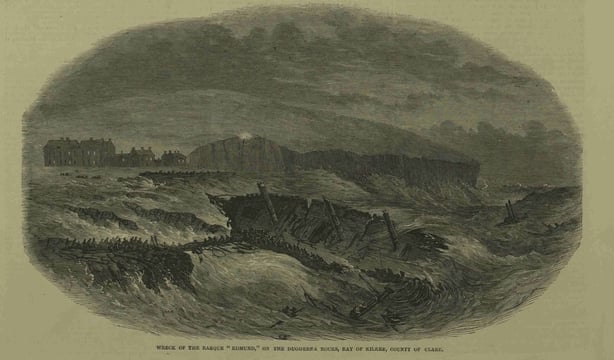
Shipwrecks enjoyed sensational coverage in the contemporary press (and in popular memory) but had minimal impact on overall emigrant mortality rates. Of the three million souls who embarked on Irish and British sailing ships between 1847 and 1855, only 0.11 per cent died in an accident at sea.
The voyage to Quebec in 1847 remains a large, black spot on the map of Irish emigration for reasons that are detailed below but outside of 1847, the passage to Canada was relatively safe. The average mortality rate on Irish emigrant ships across the other Famine years never went above the European average. In 1846, it was below 0.8 per cent.
The Irish were relatively safe when sailing elsewhere too. In his analysis of European migration to New York between 1836 and 1853, for example, historian Raymond Cohn has shown that ‘the immigrant’s country of origin had no effect on mortality’. The average death rate on ships that sailed from Ireland to New York in 1847 was 1.3 per cent.
The journey to Australia was even safer. Irish Famine-era "assisted" (working-class) emigrants experienced mortality rates that were on par with others from around the UK (often less than 1 per cent). Convicts, who sailed under highly regulated programs of food, clothing, and medical care, were relatively protected as well. Between 1846 and 1855, the average mortality rate on all UK convict transports to Australia was slightly over 1 per cent. On Irish ships in particular, however, it was 0.9 per cent. Again, this was at the lower end of what would have been considered ‘normal risk’ at the time.
Black '47 and the Voyage to Quebec
So, when we talk about 'coffin ships’ and excessive rates of emigrant mortality during the Famine, we are really talking about one route in one year: the voyage to Canada (and especially Quebec) in 1847, or ‘Black ‘47’ as it has long been (rightfully) known.
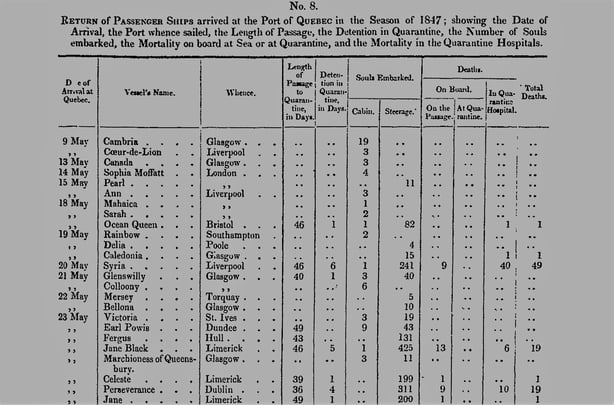
Although only 5 per cent of Ireland’s Famine-era emigrants sailed to Canada in 1847, it still looms large in the collective memory for good reason. This was the year of catastrophic losses on ships such as the Virginius and Avon, which both lost over half of their passengers in 1847.
But does the statistic of a 20 per cent average mortality rate hold up under scrutiny? The government’s chief emigration officer in Canada, Irish-born A. C. Buchanan, kept careful records of the numbers of emigrants who embarked, sailed, were born, and died en route to Quebec during the Famine years. His data for 1847 demonstrate that of the 98,749 Irish who left for that port, 10,820 died either at sea or in quarantine on Grosse Île. That is a little less than 11 per cent, which is lower than 20 per cent but still extremely high and on par with the mortality rates on slave ships in the early 1800s.
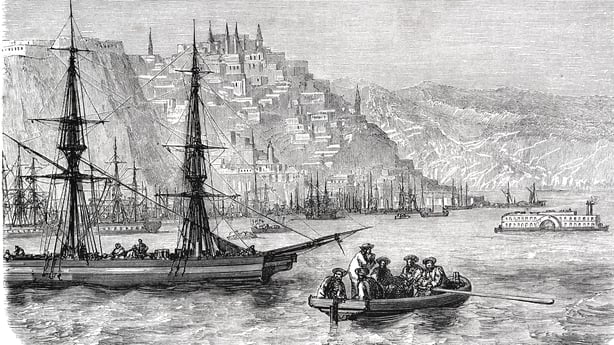
This is not to suggest, however, that all passengers faced similar threats. Cork, Ireland’s busiest port in 1847, lost a staggering 18 per cent of its 10,000 emigrants. Liverpool, through which 27,000 Irish passed in the same year, had a mortality rate of over 15 per cent. Yet Limerick (the second busiest emigration port on the island of Ireland) only lost 3 per cent of the 9,174 who emigrated through it in Black ’47. Clearly, the microbial regimes in port towns determined risk of infection and death at sea.
The Human Face of ‘Coffin Ships’
Challenging the ‘received wisdom’ about mortality rates aboard Irish emigrant ships during the Great Famine can open our minds about the past, while also influencing how we think about the present.
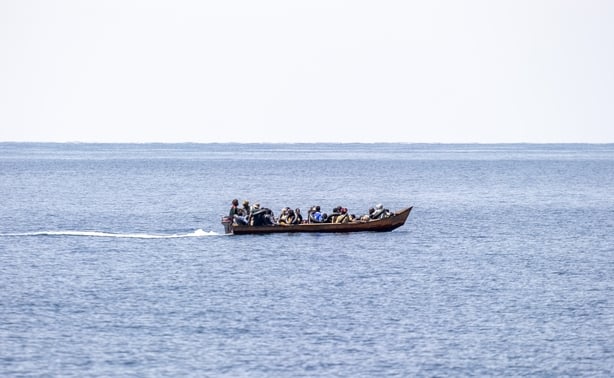
When the Titan submersible imploded off the coast of Newfoundland in June 2023, killing five wealthy tourists seeking a sneak peek at the doomed Titanic, it immediately overshadowed news coverage of a very different kind of shipwreck: just a few days earlier, over 500 refugees fleeing poverty and violence in Africa died when their disabled boat capsized off the coast of Greece.
Studies of human behaviour by social scientists like Ezra M. Markowitz and others have shown that the human capacity for compassion decreases in proportion to the ‘identifiability’ of victims. One of the reasons that the Titan enjoyed more press coverage, in other words, is that it is easier for us to sympathise with a handful of tourists whose names and faces we can see, than it is for us to connect with a faceless mass of refugees on a stricken fishing smack.
This is why taking a long, hard look at the surviving statistics can serve as a first step to properly understanding what Irish emigrants went through during the Great Famine. We owe it to ourselves, our ancestors, and our fellow human beings not to allow cardboard cut-out memories to mask the suffering and bravery of everyday people, then and now.
This piece is part of the Great Irish Famine project coordinated by UCC and based on the Atlas of the Great Irish Famine. Its contents do not represent or reflect the views of RTÉ.












































